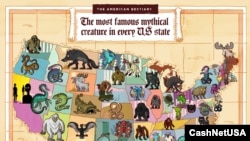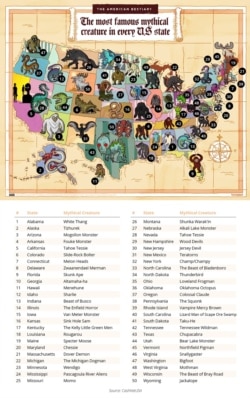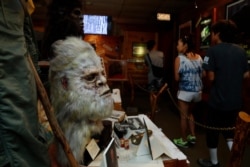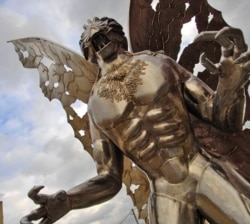Dinosaurs died out more than 65 million years ago, but don’t tell that to some people in Idaho, who believe that a dinosaur-like water creature inhabits Payette Lake near McCall.
The creature, named Sharlie — also known as the “Twilight Dragon of Payette Lake” — was first reported in 1920 when workers said they saw a moving log. In 1944, several groups of people claimed they spotted a creature with the head of a dinosaur, pronounced jaws, camel-like humps and skin similar to a shell.
Sharlie is one of many legendary creatures in American folklore. These sorts of legends are so prevalent that a recent map lays out the most famous mythical creature in each U.S. state.
“When we see these creatures and tell stories about them, what we're doing is we're saying that the world, as we know it, may not be exactly as straightforward as we think it is,” says folklorist Debra Lattanzi Shutika, an associate professor at George Mason University.
In West Virginia, for example, the mythical creature is a tall, man-like, dark figure with glowing red eyes called Mothman. There’s even a statue, museum and festival devoted to the creature that supposedly terrorized the West Virginia town of Point Pleasant and the surrounding area in the 1960s.
In Wisconsin, believers fear the Beast of Bray Road, a dark, hairy, muscular werewolf-like creature with glowing yellow eyes. Then there’s Bigfoot, in Washington state, perhaps the most famous of these mythical figures. Bigfoot is large, hairy and walks on two feet like a human. He’s so famous that he’s appeared in numerous movies and television shows.
Sharlie, Mothman, the Beast of Bray Road and Bigfoot are all examples of the sorts of myths and superstitions that are passed down through the generations, that can provide insight into a culture’s perspective.
“I think that the stories about mythical creatures could be about our deepest fears,” says Lattanzi Shutika. “But I think it's also about the way in which we see the world, you know, that the world is a big, amazing, mysterious place ... and I think it suggests more that we can't fully understand everything.”
Another of folklore’s societal uses is that it can function as a warning.
“A cautionary tale,” says Lattanzi Shutika. “When young people are out on their own in secluded areas, perhaps for different types of sensual or erotic activities, that they are vulnerable, and those vulnerabilities can be from without the car, as well as what's inside it.”
Folklore can also be educational. In this case, the lesson is that there could be could be creatures living among us that we haven't yet discovered.
While folklore is full of mysterious and magical features, not all of them are frightening, like unicorns, for example.
And the legends are usually set against the backdrop of contemporary times, according to Lattanzi Shutika, who points out that before the concept of alien abductions entered the lexicon, people told stories about fairy abductions.
Perpetuating these myths can also prove profitable for small towns that build a cottage industry around these legendary creatures. However, that doesn’t necessarily mean that Sharlie, Mothman, the Beast of Bray Road and Bigfoot are fictional.
“Folklore is the documentation and expression of informal culture. So, it's the things that we learn face-to-face ... through everyday life,” Lattanzi Shutika says. “It's how we learn our culture, so the stories that we tell ourselves about the world in which we live are definitely not necessarily false.”











